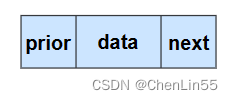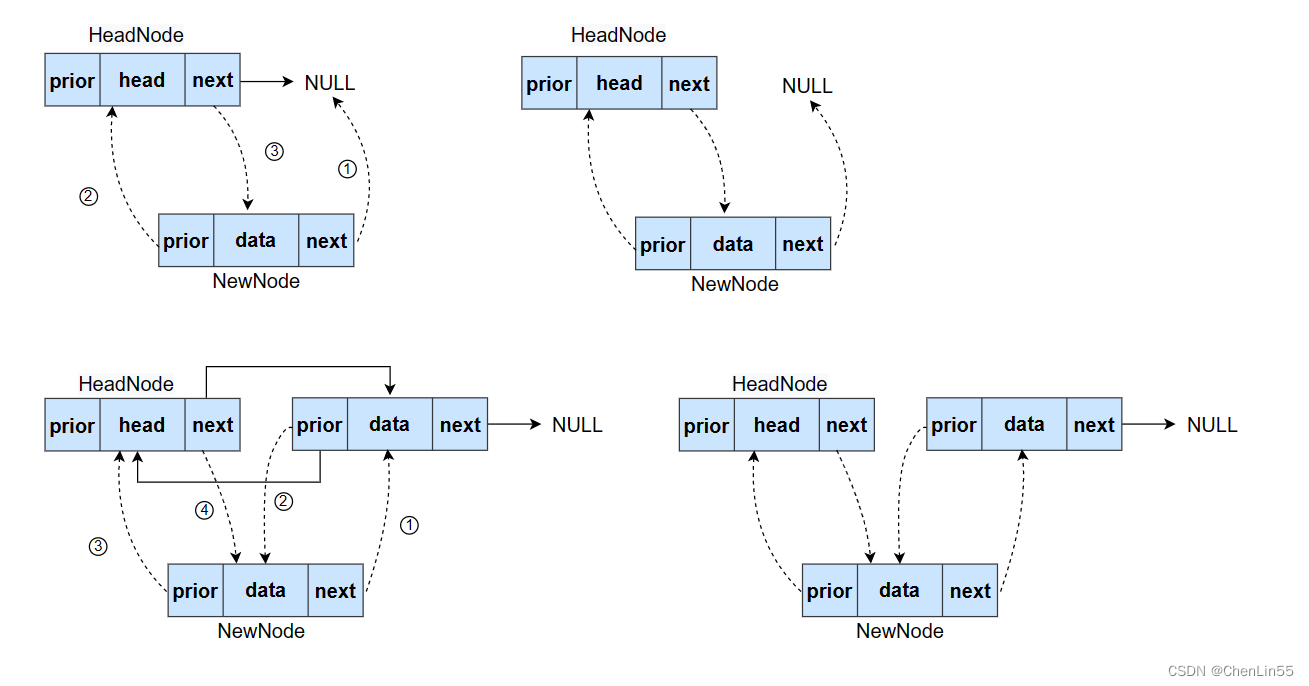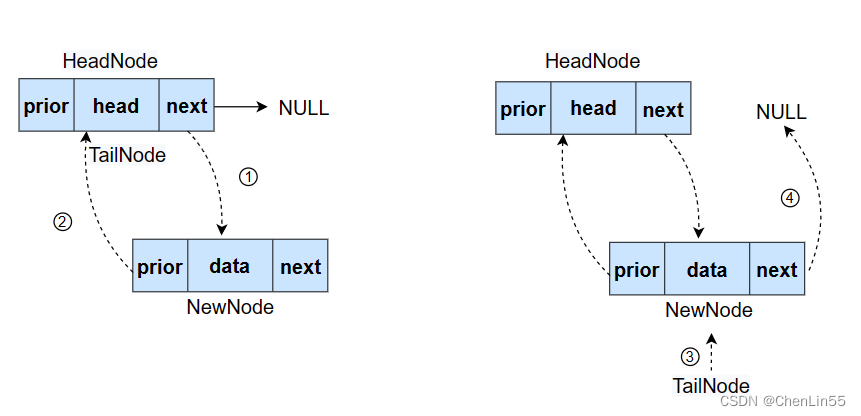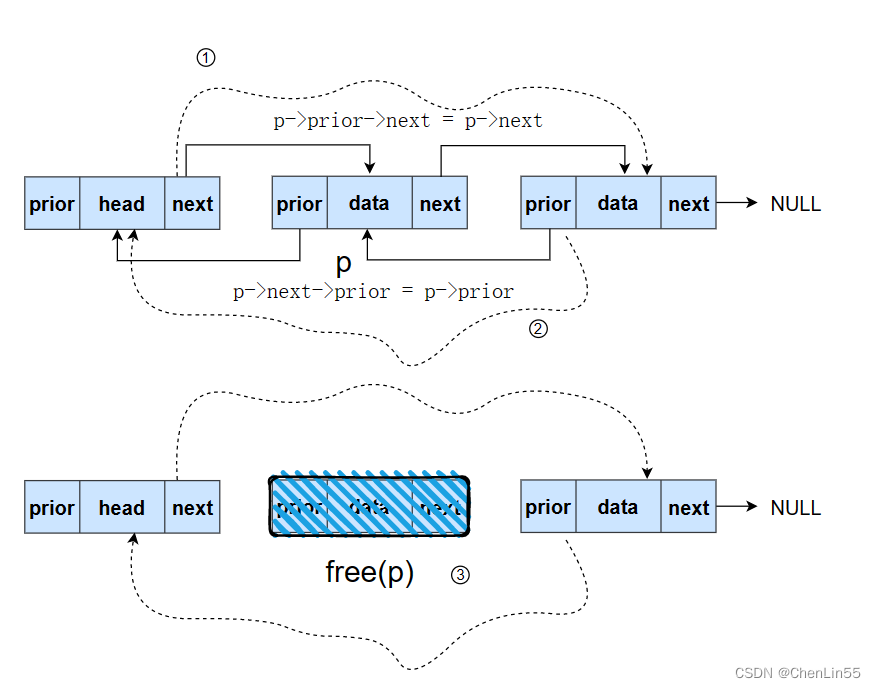双链表的认识
双链表的定义
单链表的结点中只有一个指向其后继的指针,使得单链表要访问某个结点的前驱结点时,只能从头开始遍历,访问后驱结点的复杂度为O(1),访问前驱结点的复杂度为O(n)。为了克服上述缺点,引入了双链表。
双链表的结点中有两个指针prior和next,分别指向前驱结点和后继结点。
结点结构:

带头结点链表结构:

typedef struct LNode {
ElemType data;
struct LNode* next,*prior;
}LNode, * LinkList;
带头结点优点
- 保证了每个结点都有前驱结点,因此在链表上第一个结点的操作与其他结点操作一致,无需特殊处理
- 无论链表是否为空,其头指针都是指向头结点的非空指针。可以对空表,非空表的情况进行统一处理。
双链表特点
-
每个节点都由三部分组成:
前一个节点的指针prior
保存的元素data
后一个节点的指针next -
双向链表的第一个节点的prior以及最后节点的next都是NULL
双的操作
初始化
双链表与单链表基本一致,为了操作方便加入头结点,那么初始化双链表其实就是定义一个头结点,然后将前后指针域置空。
bool InitList(LinkList& L) {
L = (LNode*)malloc(sizeof(LNode));
if (L == NULL)
{
printf("内存不足,分配空间失败");
return false;
}
L->next = NULL;
L->prior = NULL;
return true;
}
建立双链表
头插法
思路和单链表头插建表大同小异。创建一个新结点,与头结点想连接。需要注意的是一开始时HeadNode->next = NULL,那么HeadNode->next就没有prior指针域,因此HeadNode->next->prior不用指向NewNode的地址。经过建立第一个结点后,HeadNode->next存在了,因此HeadNode->next->prior指向NewNode的地址。

如果没考虑到第一个结点的特殊情况,编译器会报错引发了异常: 写入访问权限冲突,
HeadNode->next 是 nullptr。
LinkList List_HeadInsert(LinkList& L) {
InitList(L);
int x;
printf("输入链表元素(以0结束):\n");
scanf_s("%d", &x);
while (x != 0) {
LNode* head = (LNode*)malloc(sizeof(LNode));
head->data = x;
head->next = L->next;
if(L->next!=NULL)
L->next->prior = head;
head->prior = L;
L->next = head;
scanf_s("%d", &x);
}
return L;
}
头插法的特点:单链表读入数据的顺序和输出的顺序是相反的,是逆序输出,时间复杂度是o(n)。
但是双链表的遍历输出可以正序也可以逆序,这就不管建表是头插还是尾插都能正序或者逆序输出。
尾插法
尾插法相对于头插法,更简单,因为不用考虑建立第一个结点的特殊情况。方法和单链表的尾插法一直,只是多了结点的prior指针的连接。

注意:TailNode = NewNode 不要写成 NewNode = TailNode 详情解释参考上一篇单链表的博客
LinkList List_TailInsert(LinkList& L) {
InitList(L);
LNode* NewNode, * TailNode = L;
int x;
printf("输入链表元素(以0结束):\n");
scanf_s("%d", &x);
while (x != 0) {
NewNode = (LNode*)malloc(sizeof(LNode));
NewNode->data = x;
TailNode->next = NewNode;
NewNode->prior = TailNode;
TailNode = NewNode;
scanf_s("%d", &x);
}
TailNode->next = NULL;
return L;
}
遍历双链表
这是带头结点的链表,所以先找到第一个结点p,p为空则为空链表,然后遍历到尾结点就行。
遍历到尾结点后,又可以利用prior,向前遍历。
void PrintList(LinkList L) {
LNode* p = L;
if (!L->next)
printf("空链表");
else {
printf("顺序打印:");
while (p->next) {
p = p->next;
printf("%d ", p->data);
}
printf("\n逆序打印:");
while (p->prior)
{
printf("%d ", p->data);
p = p->prior;
}
printf("\n");
}
}
双链表的长度
思路就是遍历链表,记录遍历次数就是长度。
int Length(LinkList L) {
LNode* p = L->next;
int len = 0;
while (p) {
p = p->next;
len++;
}
return len;
}
查找操作
按值查找
从链表的第一个结点开始,依次比较表中各个结点的数据域的值,若某结点数据域的值等于x,则返回该结点的指针;若整个单链表中没有这样的结点,则返回空。
LNode* LocateElem(LinkList L, int x) {
LNode* p = L->next;
while (p && p->data != x) {
p = p->next;
}
return p;
}
按位查找
从链表的头结点开始,顺着指针域逐个往下搜索,直到找到第 i 个结点为止,否则返回最后一个结点的指针域NULL。
LNode* GetElem(LinkList L, int i) {
LNode* p = L;
int j = 0;
if (i<0 || i>Length(L))
return NULL;
else {
while (j < i)
{
p = p->next;
j++;
}
}
return p;
}
当然你也可以从第一个结点开始,往下搜索。我为了方便后续操作找到头结点,所以是从头结点往下搜索。
插入操作
将值为x的新结点插入到单链表L的第i个位置上。从表头开始遍历,查找第 i-1个结点,即插入位置的前驱结点为p,然后利用前插操作,令新结点s的指针域指向p的后继结点,再令p的后继结点的prior指针域指向新结点s,s的prior指针指向i位置结点的前驱结点,最后p的next指针指向s结点完成插入。
bool Insert(LinkList& L, int i, int x) {
if (i < 1 || i>Length(L))
return false;
LNode* p = GetElem(L, i - 1);
LNode* s = (LNode*)malloc(sizeof(LNode));
s->data = x;
s->next = p->next;
p->next->prior = s;
s->prior = p;
p->next = s;
return true;
}

从插入操作就能体现出GetElem函数从头结点往下搜索的好处,它能找到第一个结点的前驱结点(头结点),因此就不用特殊处理第一个结点了。
删除操作
将单链表的第 i 个结点删除。先检查删除位置的合法性,然后从头开始遍历,找到i结点,可以直接访问前驱和后继结点。修改前驱结点next指向以及后继结点prior的指向最后再释放结点p的存储空间。

bool Delete(LinkList& L, int i)
{
if (i<1 || i>Length(L)) {
printf("输入不合法\n");
return false;
}
LNode* p = GetElem(L, i);
if (!p)
return false;
p->prior->next = p->next;
p->next->prior = p->prior;
free (p);
return true;
}
完整代码及实例
完整代码
#include<stdio.h>
#include<stdlib.h>
typedef int ElemType;
typedef struct LNode {
ElemType data;
struct LNode* next,*prior;
}LNode, * LinkList;
bool InitList(LinkList& L) {
L = (LNode*)malloc(sizeof(LNode));
if (L == NULL)
{
printf("内存不足,分配空间失败");
return false;
}
L->next = NULL;
L->prior = NULL;
return true;
}
LinkList List_HeadInsert(LinkList& L) {
InitList(L);
LNode* NewNode, * HeadNode = L;
int x;
printf("输入链表元素(以0结束):\n");
scanf_s("%d", &x);
while (x != 0) {
NewNode = (LNode*)malloc(sizeof(LNode));
NewNode->data = x;
NewNode->next = HeadNode->next;
if(HeadNode->next!=NULL)
HeadNode->next->prior = NewNode;
NewNode->prior = HeadNode;
HeadNode->next = NewNode;
scanf_s("%d", &x);
}
return L;
}
LinkList List_TailInsert(LinkList& L) {
InitList(L);
LNode* NewNode, * TailNode = L;
int x;
printf("输入链表元素(以0结束):\n");
scanf_s("%d", &x);
while (x != 0) {
NewNode = (LNode*)malloc(sizeof(LNode));
NewNode->data = x;
TailNode->next = NewNode;
NewNode->prior = TailNode;
TailNode = NewNode;
scanf_s("%d", &x);
}
TailNode->next = NULL;
return L;
}
//遍历操作
void PrintList(LinkList L) {
LNode* p = L;
if (!L->next)
printf("空链表");
else {
printf("顺序打印:");
while (p->next) {
p = p->next; // 头结点数据域为空,因此直接从头结点的下一结点开始遍历
printf("%d ", p->data);
}
printf("\n逆序打印:");
while (p->prior)
{
printf("%d ", p->data);
p = p->prior;
}
printf("\n");
}
}
int Length(LinkList L) {
LNode* p = L->next;
int len = 0;
while (p) {
p = p->next;
len++;
}
return len;
}
LNode* LocateElem(LinkList L, int x) {
LNode* p = L->next;
while (p && p->data != x) {
p = p->next;
}
return p;
}
LNode* GetElem(LinkList L, int i) {
LNode* p = L;
if (i<0 || i>Length(L))
return NULL;
else {
for (int j = 0; j < i; j++) {
p = p->next;
}
}
return p;
}
//将x插入到单链表L的第i个位置上
bool Insert(LinkList& L, int i, int x) {
if (i < 1 || i>Length(L))
return false;
LNode* p = GetElem(L, i - 1);
LNode* s = (LNode*)malloc(sizeof(LNode));
s->data = x;
s->next = p->next;
p->next->prior = s;
s->prior = p;
p->next = s;
return true;
}
bool Delete(LinkList& L, int i)
{
if (i<1 || i>Length(L)) {
printf("输入不合法\n");
return false;
}
LNode* p = GetElem(L, i);
if (!p)
return false;
p->prior->next = p->next;
p->next->prior = p->prior;
free (p);
return true;
}
int main()
{
LinkList L;
InitList(L);
printf("头插建立链表\n");
List_HeadInsert(L);
PrintList(L);
printf("插入99到第2位\n");
Insert(L, 2, 99);
PrintList(L);
printf("删除第1位\n");
Delete(L, 1);
PrintList(L);
printf("\n\n尾插建立链表\n");
List_TailInsert(L);
PrintList(L);
printf("插入99到第1位\n");
Insert(L, 1, 99);
PrintList(L);
printf("删除第1位\n");
Delete(L, 1);
PrintList(L);
}
测试结果
头插建立链表
输入链表元素(以0结束):
1 2 3 4 5 6 7 0
顺序打印:7 6 5 4 3 2 1
逆序打印:1 2 3 4 5 6 7
插入99到第2位
顺序打印:7 99 6 5 4 3 2 1
逆序打印:1 2 3 4 5 6 99 7
删除第1位
顺序打印:99 6 5 4 3 2 1
逆序打印:1 2 3 4 5 6 99
尾插建立链表
输入链表元素(以0结束):
1 2 3 4 5 6 7 0
顺序打印:1 2 3 4 5 6 7
逆序打印:7 6 5 4 3 2 1
插入99到第1位
顺序打印:99 1 2 3 4 5 6 7
逆序打印:7 6 5 4 3 2 1 99
删除第1位
顺序打印:1 2 3 4 5 6 7
逆序打印:7 6 5 4 3 2 1





















 1730
1730











 被折叠的 条评论
为什么被折叠?
被折叠的 条评论
为什么被折叠?








